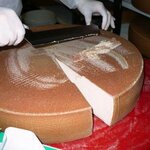Microbiology

Methicillin-resistant Staphylococcus aureus (MRSA) has become the poster child for antibiotic resistance in large part because of a larger problem: patients tend to stop taking antibiotics once they feel better. In such instances, the surviving bacteria may become impervious to the drugs designed to fight them.
A single-dose antibiotic could fix that and a new one, oritavancin, is as effective in the battle against stubborn skin infections as a twice-daily infusion given for up to 10 days, according to a recent large study.
The three-year study of oritavancin that encompassed two…

Schistosomiasis is a parasitic disease that infects 243million people worldwide, and kills about 200 thousand every year. Theinfection is contracted through contaminated waters, and in the developingworld, where is most common, is 2nd only to malaria in rates of infection andpublic health impact.
To make things worse, women, already one of the most vulnerable groups in these regions, often develop infertility secondary to the infection, with the parasite being a main cause for the problem in these regions . Places where female role is centred on being a mother, and gynaecological medical care…

There is a reason why peeing in your house is not actually a good idea - but some doctors have perpetuated the idea that urine is sterile by using that as a test for urinary tract infections.
Not that you should ever use Wikipedia for anything, but the non-expert hacktivists there botch the urine entry as further evidence. And every year the myth is debunked but it persists.
Bacteria live in the bladders of healthy women, researchers from Loyola University Chicago noted again, this time at the 114th General Meeting of the American Society for Microbiology in Boston.
"Doctors have been trained…

The rind is the boundary layer between a cheese and the environment. It hosts a variety of microorganisms that comprise the microbiome, a symbiotic community whose members perform different tasks.
Some break down proteins and fats on the rind, creating volatile sulfur and ammonia compounds that are responsible for the intensive odor of some types of cheese.
There are different curing methods for cheese. Some, like Limburger, Tilsiter and Appenzeller, need specific bacteria on their rinds. Others, like Camembert and Brie, develop their aroma with the assistance of molds. …

Researchers have reported a unique discovery; the marine dinoflagellate Dapsilidinium pastielsii in Southeast Asia, notably the Indo-Pacific Warm Pool.
This unicellular species, with planktonic and benthic stages, was previously thought to have become extinct within the early Pleistocene. It evolved more than 50 million years ago and is the last survivor of a major early Cenozoic lineage.
The discovery of living D. pastielsii in the Indo-Pacific Warm Pool suggests that this stable environment served as an important refuge for thermophilic dinoflagellates, and its…

A bacterium whose genetic material includes an added pair of DNA "letters," or bases, not found in nature has been created. The cells of this unique bacterium can replicate the unnatural DNA bases more or less normally, for as long as the molecular building blocks are supplied.
The team of researchers behind this have been working since the late 1990s to find pairs of molecules that could serve as new, functional DNA bases—and, in principle, could code for proteins and organisms that have never existed before.
The task hasn't been a simple one. Any functional new pair of DNA bases would have…

Smallpox as a disease is dead and has been since 1980. Should we let the virus behind it die?
Variola, the virus that causes smallpox, is on the agenda of the upcoming meeting of the World Health Assembly (WHA), the governing body of the World Health Organization, which is part of the United Nations.
The UN would like to destroy the last known remaining live strains of the virus but an international group of scientists led by Inger Damon, from the US Centers for Disease Control and Prevention, argue that the WHA should not choose destruction, because crucial scientific questions remain…

How can you be both a necrophiliac and chaste?
Welcome to the fascinating world of bacterial reproduction. Bacteria don't have sex the way humans think of sex - they can mix their genetic material in a process called recombination, by pulling in DNA from dead bacterial cells and inserting them into their own genome.
New research led by Imperial College London has found that this process – called recombination – is more complex than was first thought. The findings, published today in PLoS Genetics, could help us understand why bacteria which cause serious diseases are able to evade…

In old movies, humans feared invaders from other planets, but they had better watch out for us.
In "War of the Worlds" we took out the Martians using nothing but microorganisms, so if imagine if we really tried.
Interplanetary exchange of organisms is little discussed in a summer movie world of "Independence Day" invaders, but three recent scientific papers examined the risks using research from the International Space Station.
Organisms hitching a ride on a spacecraft have the potential to contaminate other celestial bodies, making it difficult for scientists to determine whether a…

It's broadly understood that the world's oceans play a crucial role in the global-scale cycling and exchange of carbon between Earth's ecosystems and atmosphere. Now scientists at Scripps Institution of Oceanography at UC San Diego have taken a leap forward in understanding the microscopic underpinnings of these processes.
When phytoplankton use carbon dioxide to make new cells, a substantial portion of that cellular material is released into the sea as a buffet of edible molecules collectively called "dissolved organic carbon." The majority of these molecules are eventually eaten by…